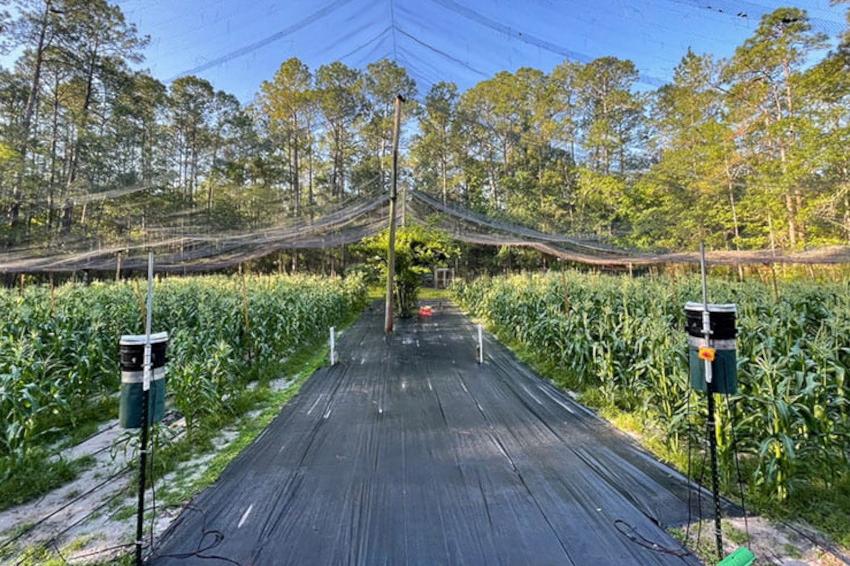Laser scarecrows make birds see red
17.01.2024 - Lasers could deliver a sustainable answer to the expensive problem of bird damage to crops.
Damage to crops caused by birds costs millions of dollars each year. Now, researchers from the University of Florida and the University of Rhode Island are investigating the effectiveness of laser scarecrows – a high-tech solution using light to deter birds. Now, they presented captive flocks of European Starlings with fresh ears of sweetcorn and demonstrated that devices emitting a moving laser beam can significantly mitigate damage to the crop, up to 20 meters from the laser device.
Kathryn Sieving from the University of Florida explained that more and more growers are seeking inexpensive and portable laser units, like the ones tested in the research. “Growers need big effects for affordable prices, and if they can spend $ 300 to $ 500 each for lasers to protect large fields for one to three weeks instead of more expensive options such as hiring people to patrol with dogs, falcons, or rifles, then lasers would be beneficial”, she said. One reason why lasers provide a particularly effective solution for the protection of sweet corn is the short timeframe before harvest in which birds would target the crop, the vulnerability window. This short window reduces the risk of birds becoming desensitised to the lasers.
Sieving explained, “Lasers are being explored widely for crops with short vulnerability windows, like sweet corn. They seem to be performing very well and especially when different non-lethal deterrents are combined (e.g., lasers with loud noises). Birds only attack sweet corn during the brief ripening phase and it lasts only 5 to 10 days. So, as soon as it ripens, harvest begins. Therefore, in sweet corn, the protection does not need to last very long, and lasers seem to be working well – surprising birds such that they leave fields with lasers, and this reduces damage during milking stages by far more than 20 %.”
The study involved two types of trials: Stick Trials, where fresh sweet corn ears were mounted on sticks at varying distances from laser units, and Natural Trials, where birds foraged on ripe corn grown from seed in a flight pen. Laser and control treatments were alternated each day over five days, allowing the researchers to assess the birds' response to repeated laser exposure. “We designed the stick trials to increase the sample size for more robust results. Natural corn matures over several weeks but then is only attractive to birds for two weeks – so our planted crop was not going to give us enough sample size. With the stick corn experiments we could study small scale effects and amp up the sample sizes,” said Sieving.
The results showed that lasers reduced sweet corn damage marginally in Stick Trials and dramatically in Natural Trials. Explaining this difference in effectiveness, Sieving noted “the sticks we presented corn on were sturdy and the birds likely could perch and feed on corn while avoiding the laser layer sometimes. Natural corn stalks are flimsy though and the birds would be bouncing in and out of the laser layer with no control. Thus, just as in larger fields it seems that natural corn makes lasers quite effective.”
The researchers also examined how distance from the lasers affected the amount of damage to the sweetcorn. They found that there was effective deterrence up to 20 meters from the laser source however beyond this distance, damage to the crop increased, with little to no deterrence at 30 meters. Sieving notes, “The data showing that relationship with distance is really the only data of its kind and was possible to get because we did the work with captive birds.”
However, she explained that in true field settings, this effect seems to be unimportant. “In open fields, birds will simply leave a field that has detectable laser protection, and they fly far out of its influence. It seems that just one laser per field can often do the trick to keep birds mostly out of a field. So, the fine scale spatial effects might only apply if birds were overly committed to feeding a small area – then a grower may need to add a couple of laser units with overlapping ranges.”
Sieving hopes that laser scarecrows can offer a sustainable solution for the protection of crops with short vulnerability windows. “Lasers are silent, unlike acoustic deterrents (loud bangs, other noises occurring several times per hour) which can be very disturbing to neighbours and workers. Lethal deterrents require permits and time and labour to apply and the potentially toxic secondary effects on wildlife, soil and water are often unacceptable.” (Source: U. Florida)
Link: Dept. of Wildlife Ecology and Conservation, University of Florida, Gainesville, USA







